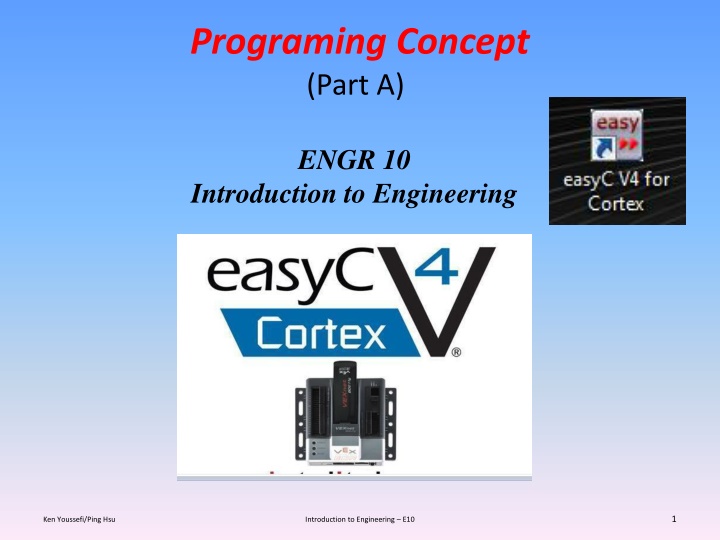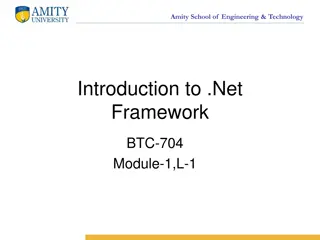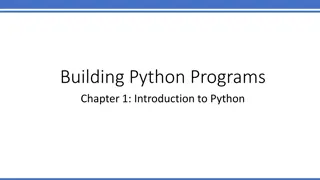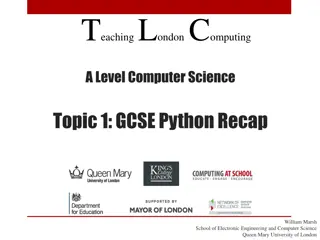Introduction to Computer Programming in Engineering
Computer programming in engineering involves breaking down tasks into small steps to instruct a computer. This process requires understanding programming languages such as C, C++, and Java, and concepts like Object-Oriented Programming (OOP). The sequential execution of expressions and the importance of choosing the right language are also discussed.
Download Presentation

Please find below an Image/Link to download the presentation.
The content on the website is provided AS IS for your information and personal use only. It may not be sold, licensed, or shared on other websites without obtaining consent from the author.If you encounter any issues during the download, it is possible that the publisher has removed the file from their server.
You are allowed to download the files provided on this website for personal or commercial use, subject to the condition that they are used lawfully. All files are the property of their respective owners.
The content on the website is provided AS IS for your information and personal use only. It may not be sold, licensed, or shared on other websites without obtaining consent from the author.
E N D
Presentation Transcript
Programing Concept (Part A) ENGR 10 Introduction to Engineering 1 Ken Youssefi/Ping Hsu Introduction to Engineering E10
What is Computer Programming ? Programming is breaking a task into small steps As a computer programmer, your job is to instruct a computer to perform tasks One thing that you will realize quickly is that a computer is very dumb, but obedient. It does exactly what you tell it to do, which is not always what you wanted. 2 Ken Youssefi/Ping Hsu Introduction to Engineering E10
A Math Example y = [ 3 ( a a +7) ] / b +4 a2 a2 + 7 3 (a2 + 7) = 3a2 + 21 (3a2 + 21) / b (3a2 + 21) / b + 4 3 Ken Youssefi/Ping Hsu Introduction to Engineering E10
Consider the sequential execution of the above expressions to find the value of y: y = [ 3 ( a a +7) ] / b +4 p = a x a; q = p + 7; r = 3 x q; s = r / b; y = s + 4; 4 Ken Youssefi/Ping Hsu Introduction to Engineering E10
What is a Programming Language? Computers only understand the binary language. Programming languages were developed to make it easier for us to communicate with computers. There are many different languages. The main choices, used by professional programmers, are: C, C++ and Java. C Probably the most widely-used, it is the oldest of the three languages. It's been in use since the 70s, and is a very compact , powerful and well-understood language. 5 Ken Youssefi/Ping Hsu Introduction to Engineering E10
What is a Programming Language? Object Oriented Programming (OOP) is a modern (more user friendly) programming concept where the programmer creates "objects" like real-life objects, with both properties and abilities. C++, Java are examples of widely used OOPs; MATLAB, Perl, EasyC are examples of special purpose OOPs; there are many more. C++ This language includes pretty much all of C with more features added. Its main advantage over C is that it s object oriented. 6 Ken Youssefi/Ping Hsu Introduction to Engineering E10
What is a Programming Language? Java is a computer Java runs on more than one platform without needing to be recompiled. Java runs inside web browsers, letting programmers create little applications which can run on websites. But Java historically is slower than compiled languages. written in a programming EasyC (VEX Robot) Over time, special purpose languages have been developed for specific applications - to make the programmers job easier. EasyC is a C++ based language specifically for telling the VEX robot what to do. 7 Ken Youssefi/Ping Hsu Introduction to Engineering E10
EasyCcortex new version Open a New Standslone Project and select Autonomous Only Project 8 Ken Youssefi/Ping Hsu Introduction to Engineering E10
EasyCcortex - new version Use the Window option to configure the appearance of the screen Your program is inserted here Program code Function blocks Flow chart 9 Ken Youssefi/Ping Hsu Introduction to Engineering E10
Program blocks Sensor blocks Outputs options 10 Ken Youssefi Introduction to Engineering E10
Variables A variable is a place where we store a value. A = 10 ; // The value 10 is stored in A. Value of 10 is placed in the storage location called A . So A is a variable A semicolon is requiredat the end of each instruction. Any statement after the sign // is NOT part of the program. It is a comment made by the programmer. 11 Ken Youssefi/Ping Hsu Introduction to Engineering E10
Variables Every variable in the program needs to be declared in the beginning of the program. Declaration of the variable tells the program its name and its type intspeed ; The word int indicates that the variable speed is an integer variable. 12 Ken Youssefi/Ping Hsu Introduction to Engineering E10
Commonly Used Variable Types Variable Type Description Range Stores integer values EX: 5, -3200 -32,768 to +32,767 215 Int Stores integer values with extended range EX: 56, 6000, -4,234,128 -2,147,483,648 to +2,147,483,647 231 Long Stores values with decimal point EX: 1.245, -4.2341 [-10^+38, -10^-38] 0 [10^-38, 10^+38] float Stores characters* EX: A, B, @, # _ char 13 Ken Youssefi/Ping Hsu Introduction to Engineering E10
Variables Global Variable This variable is accessible from anywhere within your program. Local Variable This variable is only accessible from a local area within your program ( functions will be discussed later). 14 Ken Youssefi/Ping Hsu Introduction to Engineering E10
Global Variable Declaration To declare a global variable, right click on the tab Global in the Main program and select Edit Block (or double click the block) Starting value of the variable Variable name Select variable type 15 Ken Youssefi/Ping Hsu Introduction to Engineering E10
Example of Assigning Variables 16 Ken Youssefi/Ping Hsu Introduction to Engineering E10
Assignment Operator In C language = is an assignment operator, NOT an is equal to statement. This == symbol is used for checking equal condition, not for value assignment. A = 10; // means assign 10 to A. A = B; // means assign the value of B to A A = A+1; //means assign the value A+1 // back to A, i.e., increase A by 1. 17 Ken Youssefi/Ping Hsu Introduction to Engineering E10
Assignment Operator: Examples: int A; // a variable named A of type integer int B; // a variable named B of type integer A = 10; // value 10 is assigned to variable A B = (24+16)/2; // 20 is assigned to variable B A = A + 15; // value of (A+15) is first evaluated and then assigned to A. So now A=(10+15)=25 B = A + B ; // Now A = 25, B = (25+20)=45 A = B 40; // Now A=(45-40)=5, B=45 A = A * B; // Now A=(5*45)=225, B=45 B = A / 9; // Now A=225, B=25 18 Ken Youssefi/Ping Hsu Introduction to Engineering E10
Decision Making The ability to make decision is the most basic form of intelligence. A linear (sequential) execution of instructions can only perform a simple task that does not involve decision making. Most common conditional statements are: IF statement IF - Else statement While statement 19 Ken Youssefi/Ping Hsu Introduction to Engineering E10
IF Statement (logic statement) Only if this condition is true, this instruction is executed. Example if (Number == 0) { PrintToScreen ( The Number is Zero ); } if (Number < 0) { PrintToScreen ( The Number is negative ); } 20 Ken Youssefi/Ping Hsu Introduction to Engineering E10
IF Statement Select, drag and drop the IF statement into the flow chart 21 Ken Youssefi/Ping Hsu Introduction to Engineering E10
IF-ELSE Statement IF-ELSE statement should be used where there are only two possible cases. If (score <60) { PrintToScreen( You failed the test );} else { PrintToScreen( You passed the test );} 22 Ken Youssefi/Ping Hsu Introduction to Engineering E10
EasyCPro - Example Drag and drop the IF module, the Print To Screen, and Else module into the flow chart 23 Ken Youssefi/Ping Hsu Introduction to Engineering E10
How to Add a User Code Enter the expression to be executed Drag and drop User Code 24 Ken Youssefi/Ping Hsu Introduction to Engineering E10
WHILE Statement The WHILE statement is useful for repeating a set of instructions Suppose we have to add the first 50 positive integers 1+2+3+4+ +48+49+50 You could use a single statement: int SUM ; // integer variable for the result SUM = 1+2+3+ ..+48+49+50; 25 Ken Youssefi/Ping Hsu Introduction to Engineering E10
Much better approach is To use While statement Initialize the variables SUM and COUNTER This condition is checked first. If it is true, the block of instructions enclosed by the curly brackets { } is executed. This block of instructions is executed repeatedly until the condition is not true. Finite loop 26 Ken Youssefi/Ping Hsu Introduction to Engineering E10
Solution to Clicker question 3 Initially i = 0, x = 0. First iteration: condition 0<3 is true x = 0+0=0, i = 1 Second iteration : condition 1<3 is true x = 0+1=1, i = 2 Third iteration : condition 2<3 is true So x = 1+2=3, i = 3 Fourth iteration : condition 3<3 is false So the WHILE loop stops. int x; int i; x = 0; i = 0; while (i < 3) { x = x + i; i = i + 1; } Final Value of x is 3. 27 Ken Youssefi/Ping Hsu Introduction to Engineering E10
Finite and Infinite Loop In the previous examples we have employed condition checking in order to control the flow of execution. We have made the loop to repeat only a finite number of times. We can also make the loop to repeat infinitely The infinite loop is necessary to continuously check the signal coming from the sensor. This loop is included in the Go-To-Beacon program. Infinite loop 28 Ken Youssefi/Ping Hsu Introduction to Engineering E10
In Summary Most commonly used logic statements: IFstatement IF ELSE statement (for two cases only) ELSE IF statement (for more than two cases) WHILE loop (finite or infinite) statement Write a short program so that the robot moves forward as long as it has not encounter any obstacles (bumper sensor is not pressed), and it stops when bumper is activated (hit an obstruction). 29 Ken Youssefi/Ping Hsu Introduction to Engineering E10
Setting up the program for the Sensors Declare the variable Bumper Double click the Variable block to create a new int variable named bumper 30 Ken Youssefi/Ping Hsu Introduction to Engineering E10
Setting up the program for the Sensors Select, drag and drop the While Loop icon between the BEGIN and End In the config. window set the condition of the while loop to be 1==1, this will force the while loop to loop for an infinite amount of time 31 Ken Youssefi/Ping Hsu Introduction to Engineering E10
Setting up the program for the Sensors Select, drag and drop the Bumper Switch icon into the program in the WHILE loop 32 Ken Youssefi/Ping Hsu Introduction to Engineering E10
Setting up the program for the Sensors Set the Digital Input # to the port that the sensor is plugged in This is an infinite loop to check the signal from the bumper. If the bumper is pushed its value will change to 0 Select Bumper from the list of variables 33 Ken Youssefi/Ping Hsu Introduction to Engineering E10
Integrating Motors with Sensors Drag and drop an IF and ELSE icons from the Program Flow into the program below the sensor Set the condition for the IF statement, bumper ==1, no obstacle (not pressed) 34 Ken Youssefi/Ping Hsu Introduction to Engineering E10
Integrating Motors with Sensors Your robot will be using two motors. Drag and drop two motors in the IF loop and two motors in the ELSE loop. Set the motor ports and speeds. [ 2 , 127] ; Go forward [ 3 , -127] ; With this program, the robot moves forward as long as the bumper is not pressed (value=1). Robot will stop if it hits an obstacle (value=0) [ 2 , 0] ; Stop [ 3 , 0] ; 35 Ken Youssefi/Ping Hsu Introduction to Engineering E10
Bumper is not pressed [ 2 , 127] ; [ 3 , -127] ; Bumper is pressed [ 2 , 0] ; [ 3 , 0] ; 36 Ken Youssefi/Ping Hsu Introduction to Engineering E10























